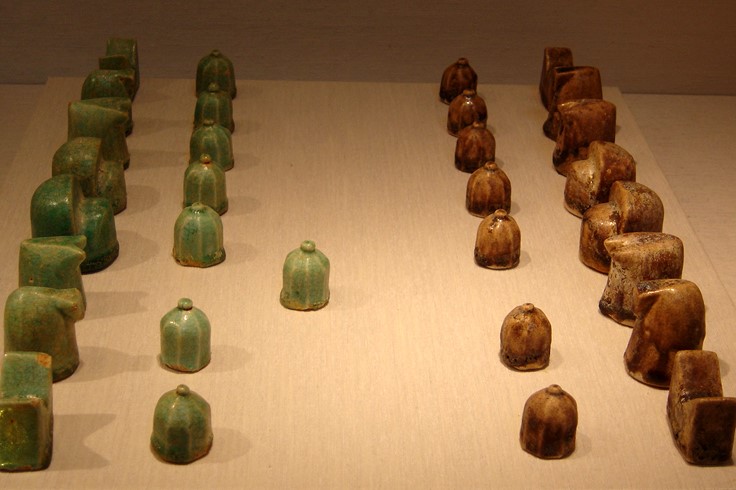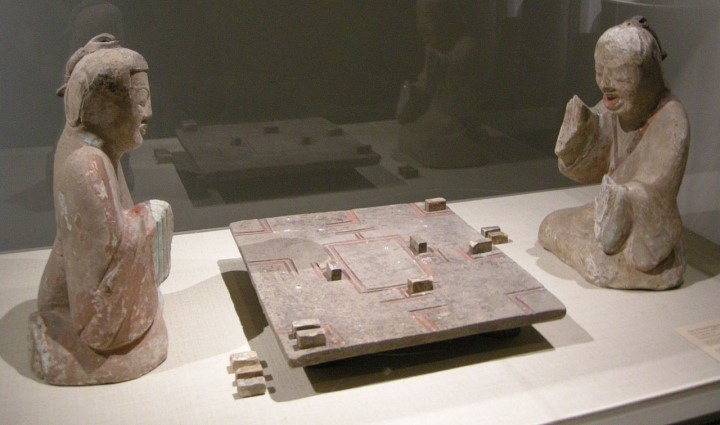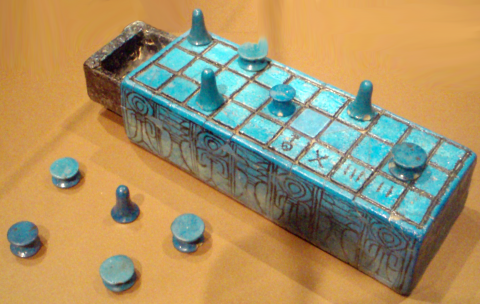


1: Introduction | 2: India | 3: China | 4: Egypt | 5: Myths, legends | 6: Cultural syncretism
At this point of the investigations on the origin of chess there are things we know, things we suppose we know and things that we ignore. Let’s list them one by one:
We know that the game arose in the Orient.
We know that there are only three theories that present valid sources to support their stance on the original source of the game: the one that locates the origin in India; the one that focuses on China, and that of cultural syncretism.
We know that a variant of proto-chess entered Persia in the sixth century AD coming from a region of India.
We suppose that this game was chaturanga, in its two-player modality, which was taken to Ctesiphon, the capital of the Persian Empire.
We know that the first precise mentions to a variant of proto-chess, coming from diverse literary sources, appear in the fourth century AD, the first of which refers to the Chinese xiang-qi and the second one to chaturanga.
We know that both xiang-qi and chaturanga had their respective transformation processes.
We know that there are two previous games that were born in these cultures, which had been recorded in literary works since ancient times: the Chinese liubo and the Indian ashtāpada.
We suppose that xiang-qi — if it came exclusively from the Chinese culture — could have been conceived from liubo.
We suppose that chaturanga — if it came exclusively from the Indian culture — could have been conceived from ashtāpada or chaturaji.
We ignore the sequence in which chaturaji and chaturanga came to be (although the predominant theory is that the latter came first), or even if chaturaji is a mere position of chaturanga.
We know that a version of xiang-qi has survived to the present day (it is currently played in China and, at least, also in Vietnam) while chaturanga disappeared as a practice at some distant moment in time.
We ignore under which precise circumstances chaturanga abandoned the use of dice.
We ignore whether the evolutionary process of chaturanga went from the four-player version to the two-player one or the other way around.
We suppose that a synthesis of several previous games was generated on the Silk Route, appearing a new prototype that later turned into chess.
We ignore if, at the end of that process, only one game arose or, if on the contrary, both chaturanga and xiang-qi appeared simultaneously.
We suppose that the games that were part of the process of cultural syncretism were liubo, ashtāpada and the Greek petteia, and possibly the process took place under the influence of an old astrolabe of Babylonian origin.
We suppose that this symbiosis occurred in a period of time between the second century BC and the third century AD.
We suppose that the process took place in a vast region occupied successively by the Kingdom of Bactria and the Kushán Empire
We know that the oldest archaeological findings of pieces that were used in some variant of proto-chess — which correlate perfectly with the geographical zones linked to the Silk Route — existed approximately in the sixth century AD.
We suppose that in the future other important archaeological elements will be discovered that, depending on their location, characteristics and antiquity, will strengthen our knowledge regarding this matter.
We know that it is necessary to deepen the analysis with regard to the theory of games, establishing greater precision and causal relationships between the various variants of proto-chess and linked practices — namely ashtāpada, chaturanga, chaturaji, liubo, xiang-qi, petteia and others.
We know that there is much yet to be investigated on the origin of chess.
We suppose that we will eventually find an answer that, without becoming an absolute certainty, at least will allow us to find a major consensus, thus establishing a uniform explanatory paradigm on the origin of chess.

Statuettes probably from the first to the second century of the Christian era representing two players disputing a game of liubo. | Photo: Wikimedia Commons
Chess might be the product of a cooperative process — and we would prefer it to be this way, to show that Humanity has the capacity to be virtuous at times (although it is known that it usually favours quarrels, often bloody, between people who seem to forget that they come from a common origin). The game could also have been an invention/creation/discovery of a single culture. Anyway, there is only one thing that is entirely certain: as Borges correctly pointed out, chess comes from the East.
In that sense, we have presented the different protohistoric versions regarding the origins of the game, focusing on that geographical space (India, China, Persia and other undetermined spots within the Silk Road), with physical or literary records that refer to a few centuries before and after the arrival of Christ.
There are quite exact records of many specific episodes, such as the time when one of the versions of the game entered Ctesiphon from India, which happened exactly in the sixth century AD. From that moment on, everything is quite clear, in terms of the diffusion of chess; before this event, however, everything is much less clear.
In this context of uncertainty, there are conflicting theses on the origin of chess, some of which have empirical support while others can only be recognized as myths or legends. All of them, with the inevitable omissions born out of the vastness of the analytical field, were compiled in this work.
After all, there are mainly three possibilities with a high degree of truthfulness and verisimilitude: two of them correspond to particular cultures — those that consider that chess comes from the Indian chaturanga or the Chinese xiang-qi; the third possibility, on the other hand, recognizes the existence of a syncretic civilizing effort, postulating a confluence of practices from different civilizations.
Beyond the validity of this trio of hypotheses, which are often each seen as independent efforts, we believe that an effort can be made to integrate the perspectives.
All the theories present elements that can be interconnected, in their complementarity, leaving aside, or perhaps reinterpreting, the divergences between them. The fact that the different variants of proto-chess have emerged in a wide but interconnected geographical space, and that this has happened in temporal synchrony, gives strong clues to a fact that we believe is incontrovertible: we are in the presence of a single family of games, with interconnected processes of evolution, which have yet to be fully discerned.
By extending the analysis, it would be possible to trace not only the interrelationship of the various proto-chess variants but also their origins in even older games. We could even go back to the Egyptian senet and, reconstructing the sequence from there on, arrive at chess as it was redefined in medieval Europe.
Under these conditions, it would be possible to work no longer from univocal, fragmented perspectives, but rather by proposing a holistic theory, integrating the evidence of each singular hypothesis, in such a way as to construct a unique, all-encompassing explanation.
Thus, instead of giving pre-eminence to chaturanga or xiang-qi an initial prototypes, it could be believed that at least one game appeared on the Silk Road from which these were derived, either concomitantly or sequentially. Therefore, in that case, the former would not derive from ashtāpada and the latter from liubo — rather, these earlier games, probably together with the Greek petteia and with the contribution of an ancient Babylonian astrolabe, produced a variant of proto-chess via cultural syncretism. This game, from then on, would expand through different routes, to the East and to the West.
So there are very interesting lines of exploration still to be developed. Although the possibility of testimonials appearing from ancient manuscripts on the subject is increasingly remote (although not entirely impossible), there could appear new archaeological findings that provide new clues, particularly in regard to the dating of games’ vestiges, which could better establish interrelationships and sequential information about these practices.
It is also possible, and indeed necessary, to continue to deepen structural analyses, based on the intrinsic characteristics and aetiology of the various games, in order to determine more precisely their correlation according to historical, geographical and cultural variables. This question is central to the design of the common evolutionary tree discussed above.
In any case, it is necessary to deepen the understanding of the practices that would have served as inputs of the proto-chess — petteia, liubo, ashtāpada — so that it will be possible to evaluate with more certainty, from the study of their particularities, the degree in which they could have had an effect in the subsequent modalities: xiang-qi and chaturanga.

A ‘senet’ board that may correspond to the 14th century B.C.
In short, where did chess originate and under what circumstances?
We could simply reproduce some well-known legendary stories, such as the ones that attribute the invention of the game to Sissa the Wise or the queen of Lanka — or even to the battle in which a sovereign lost one of her sons in confrontation with his brother.
We could focus on divinities, on the esoteric world or on fictional literature.
We could, without analysing the whole, but observing only the parts, attribute the creation of the game to Indians, Chinese or other culture.
We could say, so as not to be mistaken, although falling into an obvious imprecision — which we can only admit in poetry — that chess appeared at a distant moment in time somewhere in the East.
What I said at the beginning. The restless Humanity wants to know everything. We will never be satisfied with simple and insufficient explanations; and less so with inaccurate ones.
A holistic theory about the origin of chess can perhaps help explain the steps that were taken for the emergence of the most influential and metaphorical game ever conceived.
In any case, we believe we are closer to discovering the key that will allow us to determine the initiating moment when the game appeared. And, from that, determine with much greater certainty how the whole sequence of subsequent diffusion took place.
For now, it might be better not to know everything yet.
Thus, there is a powerful incentive to further research this topic.
In this way, a suggestive and primordial mystery continues to haunt us: when did the magical and millenary game of chess appeared on Earth.